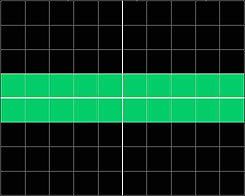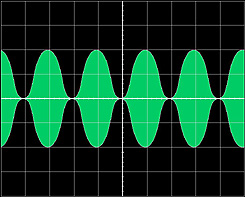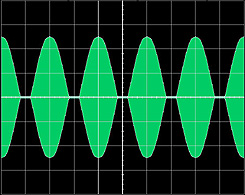This is an unmodulated carrier:
This is actually a sine wave, but it's oscillating at such a high frequency that on this oscilloscope display, all the lines bleed together and look like a single bar. (If you have a decent oscilloscope, you can crank up the timebase knob until it looks like a sine wave again.) The center horizontal line is 0 volts. The carrier rises to one division above 0 volts and drops one division below 0 volts.
This is a 100% modulated carrier:
The modulating signal is also a sine wave. This is what your output signal looks like when you whistle into the mic.
Notice that here, the positive and negative voltages now extend 2 divisions from the 0 volt line instead of one.
Now let's do the math. Ohm's law says voltage equals current times resistance:
V = IxR
Also, power (in watts) is equal to voltage times current:
P = VxI
Let's choose some simple numbers.
Let's say that our load is 50 ohms (because it usually is).
Let's also say that each full division on the scope is 10 volts.
From Ohm's law, we can calculate that with a 10 volt drop across a 50 ohm load, the current through the load is 0.2 amps (10/50). This yields an output power of 2 watts (0.2x10). That's our carrier power.
Now, if one division is 10 volts, then at 100% modulation, the voltage is doubled. So at a positive modulation peak, there would be 20 volts across the 50 ohm load. Notice that the load remains constant: your antenna should always present a 50 ohm load. (Unless maybe if you dump 10,000 watts into it and it melts.)
Now, Ohm's law tells us that with 20 volts across a 50 ohm load, we have 0.4 amps of current (20/50). This yields an output power of 8 watts (0.4x20).
So the output power on a modulation peak is 4 times that of the carrier.
You don't maintain a peak all the time though: the output varies over time, with the amplitude of the modulation signal. Usually that's your voice. With the sine wave test waveform used in this example, we can calculate average power by dividing by the square root of 2, or 1.414. That yields about 5.6 watts average power.
Now, if you over-modulate, you get this:
Notice that the positive peaks extend a little more than 2 divisions from the 0 volt line, and the negative peaks are flattened out against the 0 volt line. Those flat valleys are where your carrier is totally pinched off. That flattened waveform is a form of distortion, and distortion causes bleed over. If you crank the modulation up even higher, the positive peaks will flatten out too (when you exceed the transmitter's output capacity). Then the modulated signal will look almost like a square wave. That's where you get the worst distortion and the most bleed over.
-Bill



